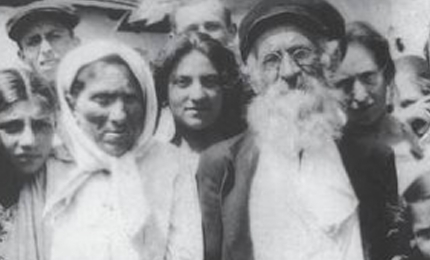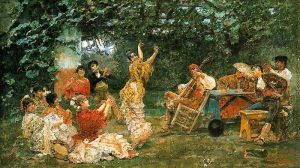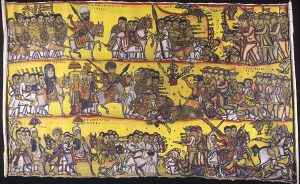“Hath not a Jew eyes? Hath not a Jew hands, organs, dimensions, senses, affections, passions; fed with the same food, hurt with the same weapons, subject to the same diseases, healed by the same means, warmed and cooled by the same winter and summer as a Christian is?”1 The words of Shylock, the main character in the Shakespearean play, The Merchant of Venice echo in my mind repeatedly in the wake of the latest Pittsburgh shooting that took place at a local temple. The shooting took the lives of eleven people during Saturday morning Shabbat on October 27th, 2018. Antisemitism has been on the rise recently in the US and around the world, persecution is not only in the tragic past of the Jewish people, but it also remains a daily reality for many. Escaping pogroms and then the Holocaust, Jews have gone into exile to avoid ethnic cleansing for centuries. Persecution remains too often the plight of the Jewish people. One such hotbed of hate is in one of the largest countries in the world that took on the name of the Union of Soviet Socialist Republics (USSR or Soviet Union) in 1917. The Soviet Union’s overreaching hand of hate has affected the lives of Jews all throughout Europe. When identifying Jews by their appearance or forcing them to wear blue or gold stars were no longer enough, Jews were often sent to live where the rest of the world did not have to see them. If anyone dared to remind others that Jews existed or should have rights, a massive amount of propaganda was often produced in reaction to ensure other gentiles conformed to hating Jews. 2

The rampant racism of the Soviet Union did not happen overnight with the fall of the Tsar in 1917.3 One of the most well-known practices of the Russian Empire was the “Pale of Jewish Settlement.” Most commonly referred to as just The “Pale of Settlement”, the area where Jews were sent to live during the Russian Empire, starting in 1772 until 1917. However, many cities within the pale still refused to allow Jews to settle within their walls. Even in this prescribed area, Jews were subjected to pogroms, large-scale, repeated riots and massacres of Jewish people. This led Jews to join the Bolshevik party and help with the revolution against the Tsar. 4 Once the Tsar in Russia fell, the people of Russia needed to figure out what kind of government they should have. The provisional government ended the practice of forcing Jews to settle within the ‘Pale’. While this seemed like a victory for Jews which helped to end the reign of the Tsar, it also marked the beginning of worse persecutions to come.
During the beginning of the Soviet Union, pogroms were common. The early Soviet pogroms killed over 150,000 Jews.5 During this time, the only force able to protect Jews was the Red Army. But even then, many units took part in these pogroms too. Despite all of this, many Jews came in droves to join the Red Army. The Red Army was the only force showing interest in stopping violence against Jews. With their new brothers in arms, the Red Army was successful in helping protect many Jews in Russia. This effort increased during World War II.6 Antisemitism was believed to be a product of Nazism in Russia, so antisemitism was a serious charge to make during the war. To help get rid of antisemitic sentiments, local and national papers downplayed and later completely excluded the fact that Germans killed millions of Jews. Instead, they simply stated that Germans had killed millions of Russians. As Nationalism grew in Russia, xenophobia became more common. With the growth of xenophobia, more antisemitism manifested within the Russian population. Since antisemitism was considered taboo, people identified as anti-Zionist which was more acceptable.7 8

In the 1920s, the government started arresting Rabbis all over Russia.9 The Jewish communities were forced to dissolve, and many Jewish properties were seized by the government. Soon the sacred language of Jews, Hebrew, was labeled elitist even by antisemitic secular Jews. All those who were caught speaking the language or teaching were persecuted. Sadly, communist Jews lead the charge in making sure the Hebrew language was washed away from Russia. This only increased the longing for a Jewish state. Many Zionists began to flee Russia and head to the United States, or to the promised land of Moses. The land that would soon be renamed as Israel, constructed as the homeland of Jews.10 Despite the attacks on the Jewish people, many Jews flourished in the new Soviet Union. Slurs like “Yid” were banned and punishable by up to one year in prison when used.11 However, this was just an attempt to secularize Jews in Russia. The government established hundreds of Yiddish Schools and newspapers that were written in Yiddish. Even a territory of Russia was given to Jews to govern themselves (although the area never had close to a Jewish Majority). The Autonomous Oblast., located in Eastern Russia has been the only other territory for Jews with an official status (official status meaning an area recognized by a government for Jews to govern and live in) other than the State of Israel.12 Jews, despite barely making up one percent of the population in Russia as a whole, made up about ten percent of all university students. This shows that for Jews in Russia, things were going well. Of course, that changed in 1929 when Stalin took power.13

The few privileges Jews had under the early Soviet Union were soon be under attack by Stalin. Shabbat, the Jewish Sabbath was banned, and then the Yevsektsiya dissolved (The section of the communist party that was for Jews), the same section of the party that helped bring an end of the use of Hebrew as a language in the Soviet Union. Next on the chopping block were Jewish members of the Red Army. During this time, Jews were placed disproportionately in the front lines of Russian conflicts. Russian Artists were imprisoned or killed, and all of this was justified by Stalin’s Anti-Semitic campaigns. The best-known being, the “Doctors’ plot.” This claim fabricated by Stalin stated that a group of mostly Jewish doctors in Moscow was plotting to end the life of Stalin. Because of this, many anti-Semitic cartoons were published to tell the Russian people to beware of Jews. On top of this, articles were published in the news telling people the threat of Zionism, and how it needs to be stopped. Another example of Stalin’s hatred for Jews would take part in “The Great Purge.” While Jews could not be “officially” targeted, great Jewish writers and artists were killed for being a “threat” to the state. Their work would be censored or destroyed before being put to death or imprisonment. Because of his numerous anti-Semitic outbursts, many feared that Stalin would force Jews of Russia to move to Siberia. Fortunately, Stalin died before this could come to fruition. 14 15

Even under Stalin, some Jews were spared, as in the case of Boris Pasternak. Today, antisemitism in Russia has changed, but not by much. While the Putin’s Administration has taken stands against antisemitism, this has not stopped people from all over Russia for calling for the banning of Jews in the country. Most acts of antisemitism in Russia consists of bombing of synagogues and defiling Jewish burial grounds. This phenomenon is not exclusive to Russia. All over the world, acts of violence against Jews were on the rise and do not seem they will stop anytime soon. Sadly, it looks like we are not any closer to solving the problems of antisemitism. However, we are not hopeless. With the creation and survival of the State of Israel, and countries like the United States that protect the rights of Jews and promote active campaigns to remember the Holocaust and other occurrences of massive human rights violations, there is some widespread support for the Jewish communities around the world. Furthermore, the Jewish state of Israel provides a safe heaven for Jews.16
- William Shakespear, 1564-1616. The Merchant of Venice (Harlow, Essex, England: Longman, 1994). ↵
- Isaac Levitats, “The Jewish Community in Russia 1772-1844, “Columbia University Press (1943). ↵
- Alex Valdman, “The Making of Jewish Revolutionaries in the Pale of Settlement: Community and Identity during the Russian Revolution and Its Immediate Aftermath, 1905-07,” Studia Judaica 20th ed. no. 1 (2017): 177–80. ↵
- John Klier and Shlomo Lambroza, Pogroms: Anti-Jewish Violence in Modern Russian History (Cambridge: Cambridge University Press, 2007). ↵
- John Klier and Shlomo Lambroza, Pogroms: Anti-Jewish Violence in Modern Russian History (Cambridge: Cambridge University Press, 2007). ↵
- Alex Valdman “The Making of Jewish Revolutionaries in the Pale of Settlement: Community and Identity during the Russian Revolution and Its Immediate Aftermath, 1905-07” Studia Judaica 20th ed. no. 1 (2017): 177–80. ↵
- John Klier and Shlomo Lambroza, Pogroms: Anti-Jewish Violence in Modern Russian History (Cambridge: Cambridge University Press, 2007). ↵
- Zeltser Arkadi “Differing Views among Red Army Personnel about the Nazi Mass Murder of Jews” Kritika: Explorations in Russian & Eurasian History 15th ed. no. 3 (2014): 563–90. ↵
- Fred Skolnik, “Russia” Encyclopaedia Judaica 2nd ed Vol 17 (Detroit: Macmillan Reference USA, 2007) 531-53. ↵
- Korey William, Russian Antisemitism, Pamyat, and the Demonology of Zionism Chur (Switzerland: Published for the Vidal Sassoon International Center for the Study of Antisemitism (SICSA), the Hebrew University of Jerusalem, by Harwood Academic Publishers, 1995). ↵
- Karel Cornelis Berkhoff, Harvest of Despair: Life and Death in Ukraine under Nazi Rule. (Cambridge, MA: Harvard University Press, 2008). ↵
- James Brooke, “Birobidzhan Journal; A Promised Land in Siberia? Well, Thanks, but . . .“ The New York Times, July 11, 1996. ↵
- William Korey, Russian Antisemitism, Pamyat, and the Demonology of Zionism Chur (Switzerland: Vidal Sassoon International Center for the Study of Antisemitism, 1995). ↵
- James L Gibson and Marc Morjé Howard. Russian Anti-semitism and the Scapegoating of Jews (Glasgow: Centre for the Study of Public Policy, University of Strathclyde, 2004). ↵
- Joshua Rubenstein, Vladimir Naumov, and Laura Esther Wolfson, Stalin’s Secret Pogrom: The Postwar Inquisition of the Jewish Antifascist Committee (New Haven, Conn Yale University Press, 2001). ↵
- Global Anti-Semitism: Selected Incidents Around the World in 2013. (Anti-Defamation League, 2013). ↵



15 comments
Sarah Uhlig
Anti Semitism will seem to always exist and it is sad that there are still people in today’s world that are judged, tortured and killed for their faith. It is sad to read about how cruel people are to Jews, especially during the Holocaust, but we need to read about this to start creating a change for the people who want to practice their faith freely. This article really expressed the situation and the reality of how these Jews are being mistreated.
Engelbert Madrid
Unfortunately, hatred is one of the things that will not be vanished in our world due to acts of violence and power. However, where there is evil, there is light and goodness in some people’s hearts. Therefore, those people must demonstrate acts of peace and love to stop the violence and hatred between groups of people. I enjoyed reading this article that included a political and social issue of antisemitism in the Soviet Union, which is still a problem in modern day Russia.
Fatima Navarro
It was an engaging and interesting article. It is sad to see a lot of antisemitism even recently, not only int the world bu the United States as well. It seems, just as the article points out, that the dislike towards Jews will not end. The title of the article was good because it does not give everything away but at the same time it does tell the reader what the content they’re about to read is about.
Christopher Hohman
Nice article. It is terrible that Jewish people have been through so much. Many people even today still hate them. This is a phenomena that I do not understand. They are people and should be treated with the upmost dignity simply based on that fact. Antisemitism can be traced back to the era of tsars and even before then. I think it was Tsar Alexander III that once said, “that we must remember that Jews killed our Lord.” It is good that many nations have laws in place that protect Jewish people, I hope that we may move forward in the right direction soon.
Gabriel Dossey
It really saddens me today that the world still sees antisemitism. We all look at the second world war as the sublimate suffering of Jews, but I think that this article is able to demonstrate that it was happening long before. You did an excellent job of describing the social structure and descrimination of jews in russia .